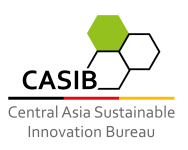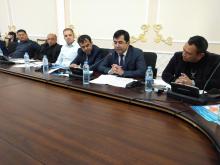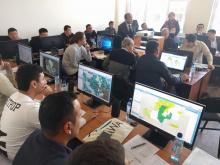MI-DAM: Multi-parameter Observation and Real-time Risk Assessment of Hydropower Plants in the Kyrgyz Republic
The infrastructure of hydropower plants in the Kyrgyz Republic is very prone to failure. The reason for this is the fact that it is largely based on obsolete systems. In particular, natural hazards such as earthquakes and landslides represent risks to the facilities today. Novel structural and environmental monitoring systems can help detect structural changes to dams and their slope environment in real time and inform decision makers in an emergency.
TRANSPOND: Transboundary Monitoring and Information System for Radioactive Contamination in the Event of Natural Hazards
Residues from Soviet uranium and rare earth production are a strain on political peace in Central Asia: For example, the erosive discharge of radioactive mining residues into the transboundary waters of Syr Darya leads to stability risks between Uzbekistan and Kyrgyzstan. Essential prerequisites for conflict prevention would be a reliable data basis for water pollution, a cross-border exchange of data and an improved infrastructure for environmental monitoring and environmental information in the riparian states. However, this has been lacking so far.
LINOKAS: Coupled Use of Linseed and Fibre Straw
Both the building materials industry and the automotive industry are seeing an increasing demand for environmentally friendly, natural raw materials. In Kazakh linseed cultivation, linseed straw is produced as a by-product, which can then be processed into a raw industrial fibre material. Up to now, however, this raw material has remained largely unused for economic purposes. The German-Kazakh project LINOKAS is therefore developing a cost-reduced and thus economically viable treatment process for linseed straw and testing on-site processing stages.
ReKKS: Innovations for Sustainable Agricultural Resource Use and Climate Adaptation in the Dry Steppes of Kazakhstan
In the dry steppe regions of Kazakhstan , problems caused by soil degradation, climate change and changes to land use are making innovations for the sustainable use of agricultural resources a necessity. In the ReKKS project, German and Kazakh partners are working closely with local partners to develop innovative, sustainable and climate-friendly agricultural concepts and procedures for reducing soil erosion and improving water, nutrient and carbon balances and - on degraded soils - steppe recultivation and applying these concepts and procedures.
Locust-Tec: Introduction of Innovative and Environmentally Friendly Technologies for Locust Management in Kazakhstan
Locust plagues are a serious threat to agricultural production, food security and the environment. They can cause severe economic damage and starvation crises and destroy vegetation and the livelihood of farmers in large areas. Current strategies for monitoring and controlling locust pests are often costly, inadequate, or have very negative impacts on health and the environment. The German-Kazakh project Locust-Tec is developing innovative technologies for monitoring and forecasting locust outbreaks as well as environmentally friendly techniques for control.
KASHEMP: Development of a Process for the Production of High-Quality Textile Hemp Fibres at Cotton Locations in Southern Kazakhstan and Implementation of German Harvest and Processing Technology
Textile production causes strong environmental impacts worldwide. For example, the cultivation of cotton consumes high amounts of water, often in low-precipitation regions. Microplastic in the environment, caused among other things by the production and use of synthetically-based textiles, is also becoming a significant environmental problem. In the KASHEMP project, German, Kazakh and Kyrgyz partners are developing the cultivation and processing of fibre hemp for the production of textile fibres based on German technologies.
ÖkoFlussPlan:Preservation of Selected Ecosystem Services in the Floodplains of the Naryn River (Kyrgyzstan)
The conservation of alluvial forests along the Naryn River in Kyrgyzstan is the focus of the international and interdisciplinary project titled "ÖkoFlussPlan". The three-year project involves partner institutions from Germany and Kyrgyzstan and has the objective of maintaining the alluvial forests of the Naryn and providing and implementing sustainable energy resources for the local population. In order to reduce the current utilisation pressure, alternatives are being developed for harvesting wood from alluvial forests.
ADRIANA: Remote Sensing-based Detection of Industrial Recyclables in Mining Tailings
The global demand for raw materials is increasing steadily, which is why the topics of recycling and the efficient use of valuable residual material streams are becoming increasingly important. In the German-Mongolian research project ADRIANA, innovative remote sensing technology is being used in conjunction with the possibilities of 3D deposit modelling in order to harness the valuable material potential of an industrial setting basin. This is a settling basin for the deposition of residues from copper ore processing in Erdenet, Mongolia.
Participation in CAWa User Forum
On Nov 7-11, the second WUEMoCA User Forum was held in the Uzbek capital Tashkent, attended by a total of 30 participants – among them delegates from the field of irrigation water management of all five Central Asian countries, representatives of international organisations, and CASIB's head of bureau Peter Liebelt.
- Read more about Participation in CAWa User Forum
- Log in to post comments
Visit to Kyrgyz-Turkish Manas University (KTMU)
On Oct 10, CASIB's head of bureau Peter Liebelt visited the Kyrgyz-Turkish Manas University (KTMU) in Bishkek, Kyrgyzstan, on Oct 10 in order to conduct an evaluation for DAAD. KTMU is among the country's leading universities. It was founded in 1995 following an agreement between Turkey and the Kyrgyz Republic; teaching activities began in 1997. Since then, KTMU has become a renowned international full-scale university with 9 faculties and 46 chairs, whose scope extends far beyond the national boundaries.



